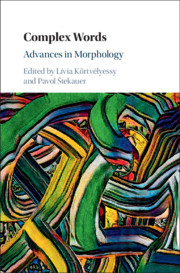Book contents
- Complex Words
- Complex Words
- Copyright page
- Dedication
- Contents
- Contributors
- Introduction: Advances in Morphology
- Part I Lexico-Semantic Aspects of Complex Words
- 1 Formal Semantics and the Problem of Nominalizations
- 2 Semantically Subtractive Morphology
- 3 -less and -free
- 4 Instrument Nouns in -one in Latin and Romance
- 5 Prominence in Noun-to-Verb Conversion
- 6 On Spanish Dvandva and Its Restrictions
- Part II Structure of Complex Words
- Part III Corpus-Based Case Studies
- Index
- References
5 - Prominence in Noun-to-Verb Conversion
from Part I - Lexico-Semantic Aspects of Complex Words
Published online by Cambridge University Press: 18 September 2020
- Complex Words
- Complex Words
- Copyright page
- Dedication
- Contents
- Contributors
- Introduction: Advances in Morphology
- Part I Lexico-Semantic Aspects of Complex Words
- 1 Formal Semantics and the Problem of Nominalizations
- 2 Semantically Subtractive Morphology
- 3 -less and -free
- 4 Instrument Nouns in -one in Latin and Romance
- 5 Prominence in Noun-to-Verb Conversion
- 6 On Spanish Dvandva and Its Restrictions
- Part II Structure of Complex Words
- Part III Corpus-Based Case Studies
- Index
- References
Summary
While conversion is assumed to be a word-formation process, at least in lexicalist theories, Dirven (1999) describes it as event-schema metonymy in a cognitive framework. Successive works suggest that this approach, which was initiated by Kövecses & Radden (1998), has not been further pursued beyond cognitive grammar. Only recently, Bauer (2018) resumed Dirven’s line of reasoning and provided convincing arguments in favour of a metonymic description of noun-to-verb conversion. The aim of the present article is to elucidate the asymmetry involved in event-schema metonymy. Since the salient participant is selected from a set of equals (i.e. from a set of participants competing to be selected as the metonymic vehicle), the question arises of what makes this participant – which contrary to the principle of anthropocentrism is not typically the Agent – stand out against its competitors. Based on selected denominal verbs especially from English, but also from Mandarin Chinese, it will be shown that this asymmetry is optimally accounted for by the abstract principle of ‘prominence’ in the sense of Himmelmann and Primus (2015) and Jasinskaja et al. (2015).
- Type
- Chapter
- Information
- Complex WordsAdvances in Morphology, pp. 82 - 99Publisher: Cambridge University PressPrint publication year: 2020

